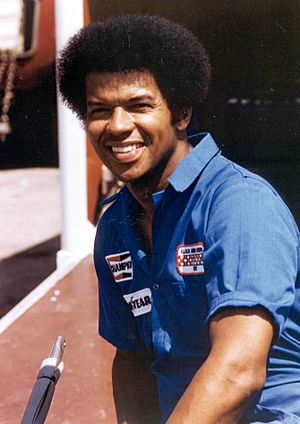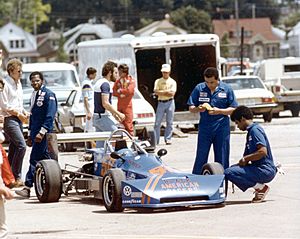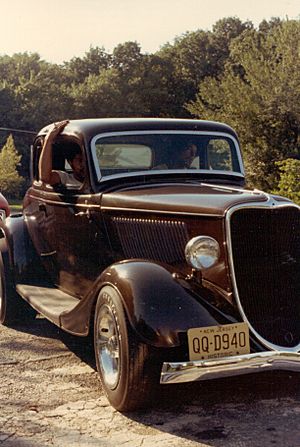Ron Hines facts for kids
Ron Hines, born in 1940, was a pioneering engineer in car racing. He was the first Black engineer with an Ivy League education to work on America's road racing tracks. In the 1970s, he worked for Black American Racers, Inc. (BAR). This was the first Black car racing team in America to get big national sponsors.
Contents
Ron Hines' Early Life
Ron Hines grew up in New Rochelle, New York. His interest in cars started when he was a teenager. At age 14, he bought a partially finished 1948 Plymouth coupe. His father, knowing Ron was too young to drive, got rid of the car.
When Ron was 16, he bought a 1949 Mercury. Again, his father did not want him to keep the car. He told Ron he was still too young to drive legally in New York.
Education and Car Passion
At Phillips Academy in Andover, Massachusetts, Ron shared a room with John Cox. John was also very interested in cars. Ron's love for cars grew stronger when John showed him a magazine article. It featured a cool 1934 Ford coupe.
In 1963, Ron graduated from the University of Pennsylvania in Philadelphia. He earned a degree in mechanical engineering. In his last year, he met Ennis Dawson, a local drag racer. They became lifelong friends.
Going to local drag races with Ennis made Ron's passion for cars burn brightly again. He bought a 1953 Studebaker coupe. He put a powerful Buick engine and a four-speed transmission in it. After some risky street races, Ron started racing his car safely. He joined sanctioned National Hot Rod Association (NHRA) events. These races took place at the Strato Rods Dragway in Wrightstown, New Jersey.
After college, Ron worked for General Motors. He was a quality control engineer in Trenton, New Jersey. In 1966, he bought a 1933 Ford coupe hot rod. He still owns this Ford today. It has changed many times over the years. It has been a trophy-winning drag racer and a cool street machine. The 1933 Ford now has a special racing engine. This engine came from a Lola T332 race car. Benny Scott drove this car for Black American Racers, Inc. in 1975.
Black American Racers Association
In 1972, Ron Hines met Leonard W. Miller. Leonard wanted to bring Black racers together into a national group. Ron, Leonard, Eugene Gadson, and Charlie Singleton started the Black American Racers Association (BARA). Ron was BARA's secretary for five years. He was in charge of publishing their monthly newsletter.
In 1974, Ron wrote half of the articles in the ’74 Black Racers Yearbook. This book covered the history of Black racing before World War II. It also gave advice to Black racers on how to get sponsors. Many big companies placed ads in the yearbook.
Ron Hines: A Road Racing Engineer
In 1973, Ron Hines joined Miller's road racing team. Benny Scott was the driver of their Tui Formula Super Vee (FSV) car. The team was sponsored by Brown & Williamson Tobacco Corporation. Ron was an engineer for two other BAR drivers in the 1970s. These were Randy Bethea and Tommy Thompson. He worked on cars for Sports Car Club of America (SCCA) and International Motor Sports Association (IMSA) races.
Ron tuned and set up the Lola T-324 and T-620 cars for the team. He traveled to famous race tracks. These included Lime Rock Park, Road Atlanta, Watkins Glen International, Mid-Ohio, and Road America. During this time, Ron appeared on many TV and radio shows. He was often with Leonard W. Miller and Benny Scott.
Keys to the City
In the spring of 1974, Mayor Maynard Jackson honored Ron Hines, Leonard Miller, and Benny Scott. He gave them the keys to the city of Atlanta. This happened in a ceremony at City Hall. The mayor also announced that April 20 would be Black American Racers Day. A photo of the team was in newspapers across the United States. This same photo was also in Miller's book Silent Thunder. It was also in Andrew L. Schupack's book Formula Vee/Super Vee-Racing, History, and Chassis/Engine Prep.
Trenton Speedway Event
After the 1975 racing season, BAR lost its sponsor. This happened because of issues within the tobacco company. BAR could not race for two years.
Leonard W. Miller decided to try FSV racing again. This was after Tommy Thompson, a Black driver, convinced him to continue the BAR dream in 1977. Ron Hines and Ken Wright were very important technical members of the team. Ron helped the team win an SCCA Northeast Championship. This victory happened at Pocono Raceway in Pennsylvania.
On September 27, 1978, a sad event occurred. Tommy Thompson was killed in a crash at the Trenton Speedway. During a Mini-Indy race, another car suddenly stopped in front of Thompson. This was due to a major mechanical problem. Thompson never woke up and passed away less than a week later.
A New Mission
After two years, Ron Hines became the crew chief for the BAR dirt track team. This was in 1980-81, with Bruce Driver as the driver. The team won ten races at speedways in Flemington Speedway and East Windsor Speedway in New Jersey. Bruce Driver became the first Black driver to win ten races at each of these tracks. BAR still hoped to race professionally and in the Indianapolis 500. However, many big companies turned down their requests for sponsorship.
Retirement and Community Work
Over the years, Ron Hines taught at the Granville Academy. He helped and guided young people from cities. He worked to improve their math skills. This prepared them to become future technicians or engineers.
During this time, he owned many special cars. Besides his 1933 Ford coupe, he also owns a 1975 Chevrolet Monza. This car has a powerful V-8 engine and a four-speed transmission.
Ron Hines now organizes an annual car and motorcycle show. It takes place at St. John's Baptist Church in Ewing Township, New Jersey. The show happens in July in a park next to the church. It welcomes all types of cars and motorcycles, no matter their age or make.




